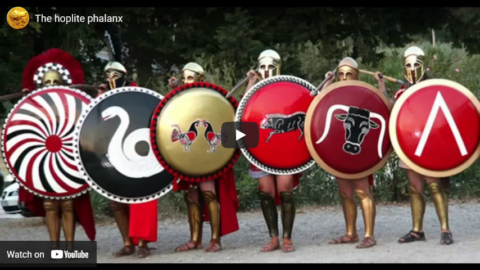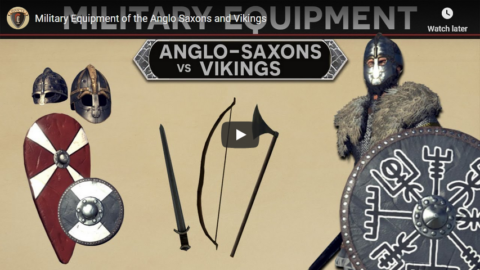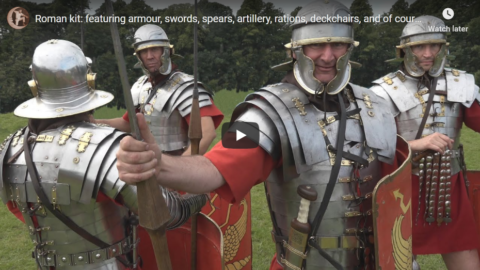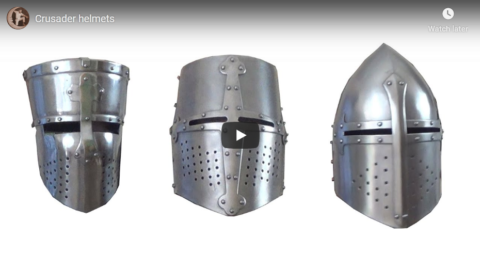Adrian Goldsworthy. Historian and Novelist
Published May 8, 2024The non citizen soldiers of the Roman Auxilia served alongside the Roman citizens of the legions. In the second and third centuries AD, there were at least as many auxiliaries as there were legionaries — probably more. Some were cavalry or archers, so served in roles that complemented the close order infantry of the legions. Yet the majority were infantrymen, wearing helmet and body armour. They looked different from the legionaries, but was their tactical role and style of fighting also different. Today we look at the tactical role of Roman auxiliaries.
Extra reading:
I mention M. Bishop & J. Coulston, Roman Military Equipment which is one of the best starting places. Mike Bishop’s Osprey books on specific types of Roman army equipment are also excellent. Peter Connolly’s books, notably Greece and Rome at War, also remain well worthwhile.
September 2, 2024
Roman auxiliaries – what was their role in the Imperial Roman army?
June 22, 2024
Why and when did the Romans start wearing different clothing and armor?
Maiorianus
Published Mar 5, 2024
May 13, 2024
Roman Legions – Sometimes found all at sea!
Drachinifel
Published Feb 2, 2024Today we take a quick look at some of the maritime highlights of the new special exhibition at the British Museum about the Roman Legions:
https://www.britishmuseum.org/exhibit…
(more…)
February 13, 2024
“I am a proud member of the Airfix generation”
I didn’t realize that Peter Caddick-Adams is the same age as me, but it does seem that our interests pretty much ran parallel for a while:
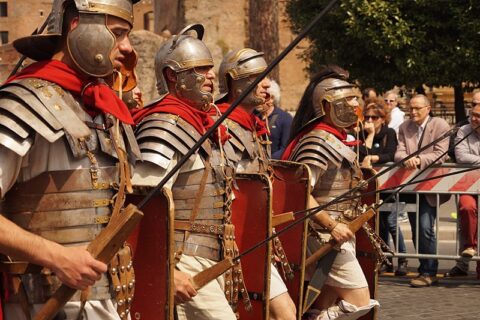
Re-enactors in Roman legionary gear, 19 May, 2021.
Original photo from https://pxhere.com/en/photo/883133 via Wikimedia Commons.
I am a proud member of the Airfix generation. The desire (less so the ability) to assemble and paint plastic model kits of aircraft, tanks and ships hit me squarely between the eyes on my tenth birthday in 1970. Several aunts and uncles had arrived at the same solution to bring out my inner Spitfire on the same day. Who needed the high of polystyrene cement and Humbrol enamel when you could refight D-Day across your bedroom floor with kits costing as little as 1/6d? Although Airfix was the premium producer of scale kits, other competing brands included Frog, Tamiya, Monogram, Hasegawa and Revell. I wish I knew what I did with them all, but many of the aircraft I recall casting out of upstairs windows, set on fire by match and candle. Looking back, I can see how it sewed the seeds of my becoming a professional military historian decades later. From little acorns, eh?
Two years later, I discovered I was interested in anything historical when my parents packed us into a train (great excitement in itself) for a trip to London. Although long past the days of steam, I can remember my father walking me down to thank the engine driver for getting us safely into Euston and then the true adventure began. The arrival at the British Museum to see the Tutankhamun Exhibition, which ran from March to December 1972. When it ended, besides the young Caddick-Adams, 1.6 million visitors had passed through the exhibition doors, making it the most popular attraction in the museum’s history. My favourite art class activity thereafter altered from drawing Spitfires and Messerschmitts chasing each other across every page to depicting ghostly, golden burial masks. Ever since, I have held an unbelievably soft spot for the old BM, always remembering that due to its vastness, it is best to go there to see something specific, rather than wander hither and thither, lost in its many treasures.
Then in 1977, when studying Ancient History for “A” Level, it was the turn of the Royal Academy in Piccadilly to capture my imagination with its Pompeii AD 79 exhibition. Mosaics, personal possessions, wall paintings and plaster casts of Romans and their animals caught in the moment of death as toxic gases, ashes, molten rock and pulverized pumice froze them forever, like insects in amber, likewise left a profound mark on my understanding of the bigger wheels of history.
The other day I was more than happy to be reunited with my old friend, the British Museum, this time hosting another Roman exhibition, which promises to be every bit as impactful as the Tutankhamun and Pompeii antecedents. Just unveiled, Legion: Life in the Roman Army is an inspired portrayal of an institution which numbered around 450,000 at its peak in AD 211 (33 legions and c. 400 auxiliary regiments), although numbers always fluctuated. The first amazing realisation is how little archaeological evidence remains of this vast organisation that endured for many centuries. The second is how well the scanty remnants in this exhibition have been preserved and interpreted.
Here, the British Museum has assembled the best surviving examples of arms, armour and personal possessions from collections around the world, in over 200 artefacts from 28 lenders. Though we view gleaming bronze helmets, swords long-rusted into scabbards, a pile of near-fossilised chainmail, it is incredible to think that there is only one intact example remaining of all those hundreds of thousands of rectangular and curved legionary shields (called a scutum), still bearing its decoration and crimson dye. This one comes from Syria.
There are some fine funerary carvings of Roman officers from around the empire, then we encounter some of the battlefield detritus including breastplate armour found near Kalkriese, in the Teutoburgerwald of Lower Saxony. This is where a coalition of Germanic tribes led by a rebel chieftain called Arminius ambushed 3 legions led by Publius Quinctilius Varus in 9 AD. The story of discovering this battle terrain was as dramatic as the assault itself. It was the result of a meticulous British soldier who combed an area north of his base at Osnabrück with a metal detector in 1987. Major Tony Clunn recorded each discovery of Roman coins and sling shot, making it possible to reconstruct the route taken by Roman legionaries under Varus and determine where they were ambushed and massacred.
January 3, 2024
September 9, 2023
The Mystery of Greek Warfare – What You “Know” is Wrong (Part 1 of 4)
Invicta
Published 8 Sept 2023In this series we will explore the mystery of Greek warfare!
What you think you know is most likely wrong. The problem with our understanding of ancient Greek warfare is that no one has been a hoplite or seen them fight. We are therefore left to reconstruct models of combat. This is complicated by the fact that Greek hoplites themselves evolved over the years as have the schools of thought for interpreting clues from the past. To break this impasse, our friend, professor Paul Bardunias, has pioneered experimental research meant to validate or falsify the claims of historians.
In this first episode we will set the foundations for this discussion by exploring the evolution of the hoplite and comparing the competing schools of thought regarding their warfare.
(more…)
June 30, 2023
QotD: Changing patterns of combat on the Great Plains
The popular image of the Great Plains Native America is unarmored, of course, but that image fundamentally formed in the late 19th century, when – after centuries of the development of gunpowder weapons – everyone was unarmored. A longer view shows that Plains Native Americans were perfectly capable of both developing or adopting defensive measures which worked. And to get a full sense of that, we need to outline the major phases of the changing warfare on the Great Plains.
F.R. Secoy (op. cit.) essentially breaks warfare into four phases, which happen at different times in different places, based on if they have horses, guns, both or neither. Because horses entered the Great Plains from the South (via the Spanish) but firearms entered the region from the North (via the British and the French, the Spanish having prohibited gun-sales to Native Americans) and spread out from there, for a brief time many of these systems were active on the Plains at once, as both guns and horses diffused through the region.
In the pre-horse, pre-gun phase (described by McGinnis as well, op. cit., 8-9), battles consisted of long-range missile exchanges between warriors who stood behind large shields which protected their whole bodies. Native American warriors in this system also wore armor, heavy leather coats, laminated in multiple layers using thick hide with glue that was sometimes mixed with sand or gravel (one more example of how “leather armor” is almost always hardened leather armor, not modern clothing-leather). Some of this armor may have been effectively quilted leather as well. Clearly, there was plenty of concern about survivability here.
Both guns and horses were apt to disrupt this system. Horses allowed attackers to rapidly close the distance between the two opposing lines of shield-protected foot-missile-warriors, causing the shield-lines to drop away (though smaller shields, used on horseback to ward off arrows and blows were still used) and for both sides to seek instead the mobility of mounted fighting. That was not the end for armor though, because contact with a supply of horses meant contact with the Spanish, and the Apache at least swiftly adopted some of the Spanish methods of making leather “buff coats” into their own armor tradition and copied the shape and pattern of the buff coat itself (while often still making the material using their own tradition). As Secoy notes (op. cit., 18-20), our sources are quite clear that these forms of armor (both original and Spanish-influenced Native armors) were quite effective at resisting the archery fire that dominated both the pre-horse, pre-gun system and the post-horse, pre-gun system.
Meanwhile on the Northern Plains, while the horse had not yet arrived, firearms had, and these had different effects. Firearms spelled the end of the armor once they became common enough, since there was no protection which could resist bullets; some shield use survived, since arrows remained fairly common as well. But this didn’t lead to suicidal warfare. Instead – as had happened on the East Coast as well, Native Americans adapted their warfare to the increased lethality of firearms (on this, note Lee, op. cit. above) by mostly avoiding pitched battles as they became too lethal (which, by the by, the relatively low lethality of pitched battles pre-gunpowder is often taken to mean that Native North American warfare in general was low-lethality; this is wrong. As with most forms of non-state warfare, most of the killing happened in surprise raids and ambushes, which could be extremely lethal and were still quite common).
Once the horse and the firearm were both in wide use in an area, warfare shifted again. War parties became smaller, faster moving and more reliant on surprise (essentially an extension of the raiding-focus of the pre-horse, post-gun system to the high mobility horses supplied). Infantry battle dropped away entirely because it was too lethal and resulted in casualties that low-population density nomads could not sustain (the contrast with the much higher population-density agrarian United States, which was self-immolating in massively costly massed-infantry engagements during the American Civil War, 1861-1865, at exactly this time is striking). These are fairly big, noticeable changes in warfare patterns!
In short, the tactics used in all four of these systems were conditions by casualty aversion, which makes a lot of sense in the context of a low-population density society which simply cannot afford massive losses.
Bret Devereaux, “Collections: That Dothraki Horde, Part IV: Screamers and Howlers”, A Collection of Unmitigated Pedantry, 2021-01-08.
April 21, 2023
QotD: In ancient Greek armies, soldiers were classified by the shields they carried
Plutarch reports this Spartan saying (trans. Bernadotte Perrin):
When someone asked why they visited disgrace upon those among them who lost their shields, but did not do the same thing to those who lost their helmets or their breastplates, he said, “Because these they put on for their own sake, but the shield for the common good of the whole line.” (Plut. Mor. 220A)
This relates to how hoplites generally – not merely Spartans – fought in the phalanx. Plutarch, writing at a distance (long after hoplite warfare had stopped being a regular reality of Greek life), seems unaware that he is representing as distinctly Spartan something that was common to most Greek poleis (indeed, harsh punishments for tossing aside a shield in battle seemed to have existed in every Greek polis).
When pulled into a tight formation, each hoplite‘s shield overlapped, protecting not only his own body, but also blocking off the potentially vulnerable right-hand side of the man to his left. A hoplite‘s armor protected only himself. That’s not to say it wasn’t important! Hoplites wore quite heavy armor for the time-period; the typical late-fifth/fourth century kit included a bronze helmet and the linothorax, a laminated, layered textile defense that was relatively inexpensive, but fairly heavy and quite robust. Wealthier hoplites might enhance this defense by substituting a bronze breastplate for the linothorax, or by adding bronze greaves (essentially a shin-and-lower-leg-guard); ankle and arm protections were rarer, but not unknown.
But the shield – without the shield one could not be a hoplite. The Greeks generally classified soldiers by the shield they carried, in fact. Light troops were called peltasts because they carried the pelta – a smaller, circular shield with a cutout that was much lighter and cheaper. Later medium-infantry were thureophoroi because they carried the thureos, a shield design copied from the Gauls. But the highest-status infantrymen were the hoplites, called such because the singular hoplon (ὅπλον) could be used to mean the aspis (while the plural hopla (ὁπλά) meant all of the hoplite‘s equipment, a complete set).
(Sidenote: this doesn’t stop in the Hellenistic period. In addition to the thureophoroi, who are a Hellenistic troop-type, we also have Macedonian soldiers classified as chalkaspides (“bronze-shields” – they seem to be the standard sarissa pike-infantry) or argyraspides (“silver-shields”, an elite guard derived from Alexander’s hypaspides, which again note – means “aspis-bearers”!), chrysaspides (“gold-shields”, a little-known elite unit in the Seleucid army c. 166) and the poorly understood leukaspides (“white-shields”) of the Antigonid army. All of the –aspides seem to have carried the Macedonian-style aspis with the extra satchel-style neck-strap, the ochane)
(Second aside: it is also possible to overstate the degree to which the aspis was tied to the hoplite‘s formation. I remain convinced, given the shape and weight of the shield, that it was designed for the phalanx, but like many pieces of military equipment, the aspis was versatile. It was far from an ideal shield for solo combat, but it would serve fairly well, and we know it was used that way some of the time.)
Bret Devereaux, “New Acquisitions: Hoplite-Style Disease Control”, A Collection of Unmitigated Pedantry, 2020-03-17.
May 29, 2022
The hoplite phalanx
HistoryMatters
Published 5 Jan 2016A short introductory video about on ancient Greek hoplite and phalanx.
Music: Wet by Michett
December 11, 2021
The Stahlhelm
World War Two
Published 10 Dec 2021The Stahlhelm. Perhaps the most iconic symbol of German military power, ever present in images of the war. Hitler believes it strikes fear in his enemies and makes his own troops fearless. But where does it come from and why is it so enduring?
(more…)
November 29, 2021
Why was the Roman Legionary’s equipment so good?
Epimetheus
Published 3 Nov 2019Arms & Armor of the Imperial Roman Legionary
The Ancient Roman legionary’s clothing, arms, armor, and equipment (Top 10 items) mini-documentary
#Legionary #documentary #RomeThis video is sponsored by my patrons on Patreon
https://www.patreon.com/Epimetheus1776
From the comments:
Epimetheus
1 year ago (edited)Check Out my video on Republican Roman Infantry:
https://youtu.be/APuh6rokd_wAdditional info/and sources
Rounded metric Conversion for units mentioned:
Typical March: 20-30 miles(32-48 km) in a day
Training march distance and load: 22 miles = 35 km, 45 pounds = 20 kg
Full campaign max carried load per Legionary: 65-100 lbs = 27-45 kgsOne thing I wrote in the script, recorded and edited out by accident was that … when a Roman Legionary was dishonorably discharged (thrown out of the legion for bad behavior) his belt was confiscated by the legion which did not want him to be associated with the Roman State.
Sources:
Roman Military Clothing by Graham Sumner
Greece and Rome at War by Peter Connolly
Roman Legionary by Ross Cowan
The Legionary by Peter Connolly
The Gladius (The Roman short sword) by MC Bishop
Warfare in the Classical World by John Warry
Caesar’s Legions by Sekunda, Northwood and SimkinsMisspelled Inches as inces and Cohort as Chohort
June 18, 2021
Boob Armor: 4 Things You Need to Know
Jill Bearup
Published 1 Mar 2021Designing some armour for ladies? Female torso armour specifically? Welcome. Get a year of streaming some of your favourite creators and HQ documentaries for under $15 at http://curiositystream.com/jillbearup
Boob armour, or boob plate, or lady armour. Or fantasy lady armour, come to that: how does it work then? Let’s have a look at Wonder Woman, The Mandalorian, Warhammer 40K and various examples of historical armour, as well as costume considerations, which will make designing a look for your female fighters that is practical and looks awesome a breeze.
TIMESTAMPS!
00:00 So you need some lady armour?
00:37 1. You don’t need boob plate
02:23 Alternate options
03:14 2. Divots are a disadvantage
03:56 Muscle cuirasses
04:35 Boob shelf designs
05:11 Cleavage divots
05:39 Wasp waist armor
06:44 Sticky weapons
08:02 Codpieces
08:40 3. Consider mobility (including experiments)
09:35 Two handed weapons and giant swords
10:29 Underlayers and materials used in experiments
11:03 Low guards and power generation in boob plate
11:46 Not painting a ‘look, a lady!’ target on yourself with your armor
12:17 4. Breathing is important
13:44 Corsets are not like armor, and scifi armor with flex
15:44 Fencing chest protectors are not armor, extra content on Nebula, this video is sponsored by Curiosity Stream
16:49 Lightning round#boobplate #femalearmor #armor
Music by epidemicsound.com
“Meet Me in the Hills” – Howard Harper-Barnes
“To Begin” – Raymond Grouse
“Honorable Salute” – Sage Orsler
“Plains of Illeyneth” – Dragon Tamer
“Sparkle and Swirl” – Raymond Grouse
“Sergeant Wise” – Stationary Sign
“Optimist At Heart” – Jerry Lacey
“Fluz de la Riviere” – Howard Harper-Barnes
“Sailing for Gold” – Howard Harper-Barnes
“Endless Flirtation” – Jerry Lacey
August 31, 2020
Military Equipment of the Anglo Saxons and Vikings
Invicta
Published 19 Apr 2018Today we dive into the world of Early Medieval England to analyze the military equipment available to the warring Anglo Saxons and Vikings!
Support future documentaries: https://www.patreon.com/InvictaHistory
Twitter: https://twitter.com/InvictaHistoryDocumentary Credits:
Research: Invicta
Script: Invicta
Artwork: Osprey Publishing
Game: Total War Saga: Thrones of Britannia
Editing: Invicta
Music: Total War: Attila and Total War Battles: Kingdoms SoundtrackLiterary Sources
–Anglo-Saxon Thegn by Mark Harrison (Osprey Publishing)
–Viking Hersir 793–1066 AD by Mark Harrison (Osprey Publishing)
–Saxon, Viking and Norman by Terence Wise (Osprey Publishing)
July 28, 2020
Roman kit: featuring armour, swords, spears, artillery, rations, deckchairs, and of course shoes
Lindybeige
Published 27 Jul 2020Go to https://expressvpn.com/lindybeige and find out how you can get three months free.
A video of re-enactors and their Roman kit. Sorry about the wind noise.
Support me on Patreon: https://www.patreon.com/Lindybeige
Here’s a link to the Ermine Street Guard – Britain’s foremost imperial Roman re-enactment group: http://www.erminestreetguard.co.uk
Was your re-enactment group featured? Ask for a link here!
Buy the music – the music played at the end of my videos is now available here: https://lindybeige.bandcamp.com/track…
Buy tat (merch):
https://outloudmerch.com/collections/…Lindybeige: a channel of archaeology, ancient and medieval warfare, rants, swing dance, travelogues, evolution, and whatever else occurs to me to make.
▼ Follow me…
Twitter: https://twitter.com/Lindybeige I may have some drivel to contribute to the Twittersphere, plus you get notice of uploads.
My website:
http://www.LloydianAspects.co.uk
July 4, 2020
Crusader helmets
Lindybeige
Published 4 Sep 2014Here I show you three common styles of crusader helmet, and I comment upon them.
Thanks to Dr David Tetard for the loan of his helmets. These particular ones were bought here:
www.getdressedforbattle.co.uk
http://www.kovexars.cz/index.php (HL 007 and 103)Lindybeige: a channel of archaeology, ancient and medieval warfare, rants, swing dance, travelogues, evolution, and whatever else occurs to me to make.
▼ Follow me…
Twitter: https://twitter.com/Lindybeige I may have some drivel to contribute to the Twittersphere, plus you get notice of uploads.
website: www.LloydianAspects.co.uk

